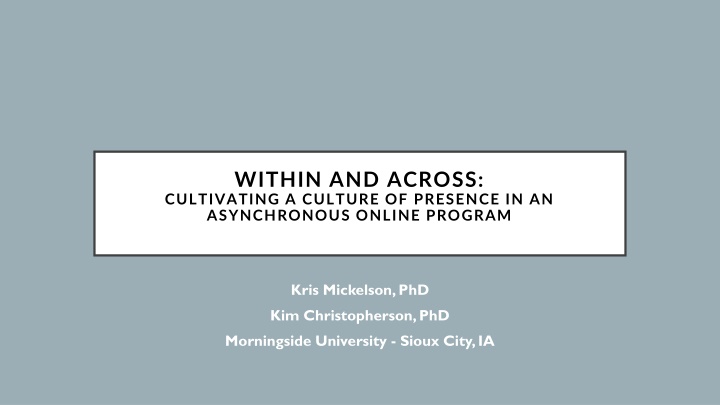
Cultivating Online Presence in Asynchronous Programs
Explore strategies for building a culture of presence in an asynchronous online program, focusing on learning outcomes, program context, online presence concepts, challenges, and collaborative design. Discover how to implement continuous improvement and enhance student engagement through surveys and feedback.
Download Presentation

Please find below an Image/Link to download the presentation.
The content on the website is provided AS IS for your information and personal use only. It may not be sold, licensed, or shared on other websites without obtaining consent from the author. If you encounter any issues during the download, it is possible that the publisher has removed the file from their server.
You are allowed to download the files provided on this website for personal or commercial use, subject to the condition that they are used lawfully. All files are the property of their respective owners.
The content on the website is provided AS IS for your information and personal use only. It may not be sold, licensed, or shared on other websites without obtaining consent from the author.
E N D
Presentation Transcript
WITHIN AND ACROSS: CULTIVATING A CULTURE OF PRESENCE IN AN ASYNCHRONOUS ONLINE PROGRAM Kris Mickelson, PhD Kim Christopherson, PhD Morningside University - Sioux City, IA
LEARNING OUTCOMES 1. Learn new online presence structures and strategies to build a consistent culture of presence across an entire program area 2. Develop consistent expectations and practices for teacher, social, and cognitive presence by exchanging ideas across institutional settings 3. Identity and problem-solve unique institutional challenges to building a program culture of presence.
THE CONTEXT: OUR PROGRAM Asynchronous Master s Program for Teachers 5 Course Research Sequence w/ Action Research Project Lots of Students, Sections, Adjuncts
THE CONCEPT: ONLINE PRESENCE Teaching Social Cognitive
THE CHALLENGE: HOW DO WE CULTIVATE PROGRAMMATIC PRESENCE? What is a program area in your professional setting that would benefit from programmatic thinking?
RESPONDING TO THE PROGRAMMATIC CHALLENGE Collaborative Design and Continuous Improvement Threaded Learning Tools Faculty Mentoring and Development Design Process Research Journal Instructor Notes Culminating Performance Assessment Community of Inquiry Survey Student Work Sample Review
COLLABORATIVE DESIGN AND CONTINUOUS IMPROVEMENT
EXAMPLE 2: CROSS-COURSE STUDENT SURVEY ABOUT PRESENCE THE INSTRUCTOR HELPED KEEP COURSE PARTICIPANTS ENGAGED AND PARTICIPATING IN PRODUCTIVE DIALOGUE. TEACHING THE INSTRUCTOR PROVIDED FEEDBACK IN A TIMELY FASHION. I WAS ABLE TO FORM DISTINCT IMPRESSIONS OF SOME COURSE PARTICIPANTS. SOCIAL ONLINE DISCUSSION HELPFED ME DEVELOP A SENSE OF COLLABORATION. COURSE ACTIVITIES PIQUED MY CURIOUSITY. COGNITIVE I CAN APPLY KNOWLEDGE CREATED IN THIS COURSE TO MY WORK OR OTHER NON-CLASS RELATED ACTIVITY.
EXAMPLE 2: SHARED CULMINATING PERFORMANCE ASSESSMENT SHARON WALKER SCHOOL OF EDUCATION Spring 2023 Initial Licensure Educators Action Research Conference Saturday, April 22 Facilitator: Dr. Kris Mickelson Saturday 1B Zoom Link 12:00 pm - 1:00 pm A Study of Specially Designed Instruction on Math Probe Scores for Special Education Students ____________________________________________________________________________Student A The Impact of Building Meaningful Relationships on Students Academic Performance in Class __________________________________________________________________________ _________Student B Taking Charge of My Own Goals: How Self-Reporting Reading Comprehension Scores Affects Students Reading Comprehension Scores ____________________________________________Student C Impact of a Daily Assigned Task List on Assignment Completion ______________________________________Student D
FACULTY DEVELOPMENT AND MENTORING
TOPIC: NOTES: WRITING CENTER SUBMISSION A. STUDENTS ARE SUBMITTING THEIR DRAFT APPLICATION ASSIGNMENT 1 S TO THE WRITING CENTER. AFTER THEY HAVE RECEIVED AND INTEGRATED FEEDBACK FROM THE WC . . . 3.1 QUANT VS. QUAL A. THE HARDEST PART OF THIS ASSIGNMENT FOR STUDENT IS USALLY PART 2: ASSUMPTION BEHIND RSEARCH PARADIGMS. WE WANT TO CULTIVATE THE IDEA THAT . . . EXAMPLE 1: INSTRUCTOR NOTES 3.2 PROBLEM STATEMENTS A. THERE IS AN EXERCISE IN 3.2 WHERE THEY DISSECT AN EXISTING PROBLEMS TATEMENT AND THERE IS AN ANSWER KEY FOR THIS ASSIGNMENT BECAUSE IT IS MORE . . . WHAT S NEW IN MODULE 3 A. FOR THE VETERANS IN THE GROUP . . . THIS ENTIRE MODULE USED TO BE ONE HALF OF A MODULE SO WE VE STRATCHED IT OUT TO ALLOW MORE TIME FOR PROCESSING BOTH . . . WHEN RESPONDING TO MODULE 2 STUDENT WORK A. IF YOU AREN T SEEING SUBSTANCE GIVE A 0/DOES NOT MEET EXPECTATIONS FOR THE CONTRIBUTIONS TO THE LEARNING COMMUNITY PIECE AND GIVE THEM A . . .
EXAMPLE 2: STUDENT WORK SAMPLE REVIEW ACTIVITY MEET TO DISCUSS AND PLAN ACTION REVIEW AND REFLECT ON GROUP S FEEDBACK SUBMIT INDIVIDUAL FEEDBACK
CONVERSATION STARTERS AT MY SCHOOL, THE TYPE OF PRESENCE WE WOULD MOST BENEFIT FROM DEVELOPING ACROSS A PROGRAM/SEQUENCE/MAJOR IS . . . THE GREATEST CHALLENGE WE EXPERIENCE TRYING TO ENSURE CONSISTENCY IN PRESENCE IN A PROGRAM/SEQUENCE/MAJOR IS . . . AN EFFECTIVE STRATEGY MY INSTITUTION HAS USED TO COLLABORATE ACROSS A PROGRAM, SEQUENCE, MAJOR IS . . .
